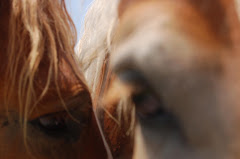On February 28th, a client called on emergency and had a horse with a fresh laceration. The client brought the mare, "Dallas", to the clinic for me to suture the laceration. This picture shows the laceration on the left side of her thorax, just behind her elbow. The picture was taken after I had shaved her hair and cleaned the wound. Evidently, she caught her skin on a door latch going inside her stall. T his is actually a very common injury. The laceration was fairly large and a "full skin thickness" laceration, meaning all the layers of the skin were lacerated. She had even lacerated the most superficial muscle layer covering her ribs. Even though these pictures do not show it well, there is a large flap of loose skin at the right edge of the laceration.
his is actually a very common injury. The laceration was fairly large and a "full skin thickness" laceration, meaning all the layers of the skin were lacerated. She had even lacerated the most superficial muscle layer covering her ribs. Even though these pictures do not show it well, there is a large flap of loose skin at the right edge of the laceration.
 his is actually a very common injury. The laceration was fairly large and a "full skin thickness" laceration, meaning all the layers of the skin were lacerated. She had even lacerated the most superficial muscle layer covering her ribs. Even though these pictures do not show it well, there is a large flap of loose skin at the right edge of the laceration.
his is actually a very common injury. The laceration was fairly large and a "full skin thickness" laceration, meaning all the layers of the skin were lacerated. She had even lacerated the most superficial muscle layer covering her ribs. Even though these pictures do not show it well, there is a large flap of loose skin at the right edge of the laceration. 
The good news was that these type of lacerations usually heal quite nicely providing they do not become infected. I would much rather have a large laceration on a horse's side, neck or head than a small laceration on a leg. Leg cuts are slow to heal due to the lack of tissue and blood supply.
After cleaning and flushing the wound thoroughly, I administered a local anesthetic to numb the area. I then, surgically debrided (removed) any skin/tissue that appeared devitalized. It is very important to excise any unhealthy tissue because unhealthy tissue can become infected tissue. I was a bit concerned about the condition of the flap of skin...however, removing the entire flap would result in a large open wound which would have to heal by second intention, meaning without sutures. So, I placed several absorbable sutures underneath the skin to close the laceration and then sutured the skin with non-absorbable sutures.

This picture shows the repaired laceration. You will notice the bottom part of the incision is left open. There was not enough healthy skin to close this area, plus leaving it open will allow drainage of fluid. After the initial "anxiety" of the tranquilization injection, Dallas stood very calmly while I sutured the laceration. She was also given antibiotics, tetanus prophylaxis and pain medication.
And voila!.....here is the laceration after approximately 3 weeks. I removed the skin sutures and a piece of dessicated, nonvital skin which was covering the pink part of the laceration. This was part of the skin flap which I was concerned about. However, this laceration looks great! There are no signs of infection and the open part of the laceration is healthy and will continue to heal. Within 4-6 weeks, there should be only a faint scar remaining! 











You my dear are an artist. The wound looks great! Would you consider doing a tummy tuck on a human?
ReplyDelete